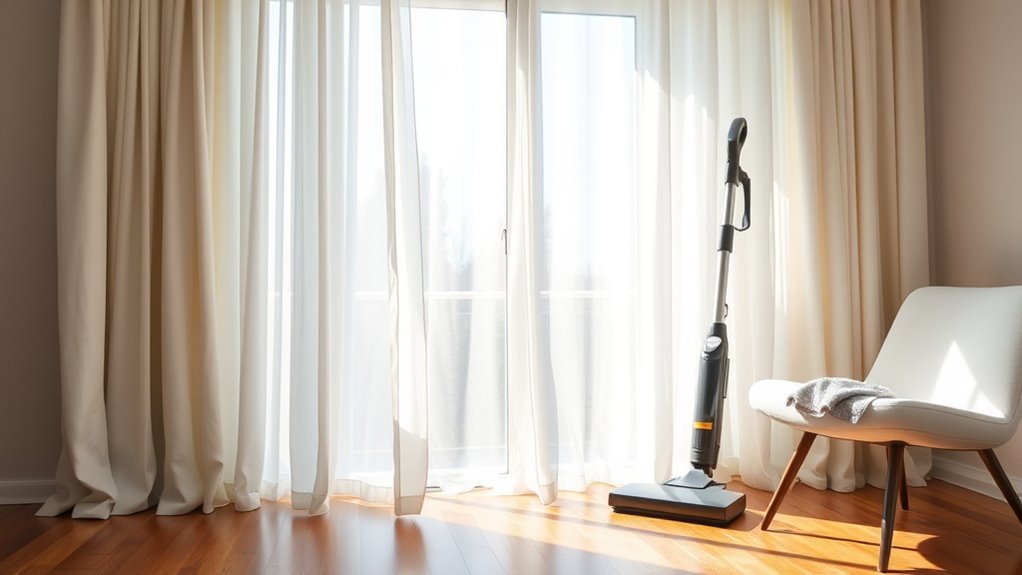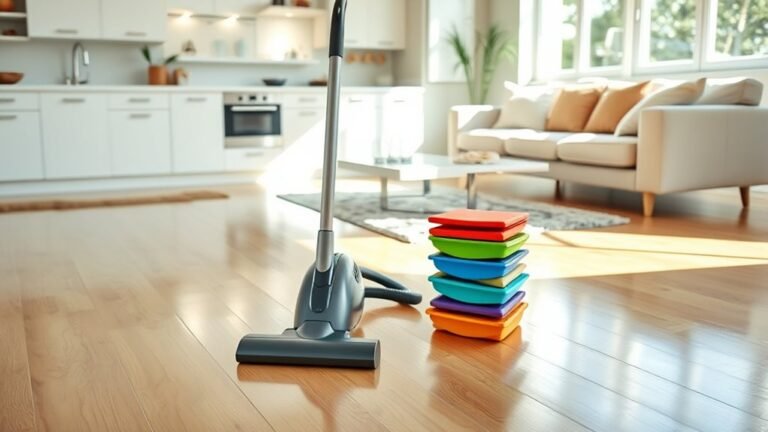Deep Cleaning Guide for Curtains Flooring
To deep clean your curtains and flooring, start by identifying curtain fabrics and flooring types. Vacuum curtains gently, then clean delicate fabrics like silk with mild detergent and cold water. For carpets, blot stains immediately and use vinegar or gentle detergent as needed before shampooing. Sweep and mop hardwood or tile floors with appropriate pH-neutral cleaners, avoiding excess water on wood. Regular maintenance protects surfaces and extends freshness. Keep going to discover detailed methods and ideal products for lasting results.
Preparing Curtains and Flooring for Deep Cleaning
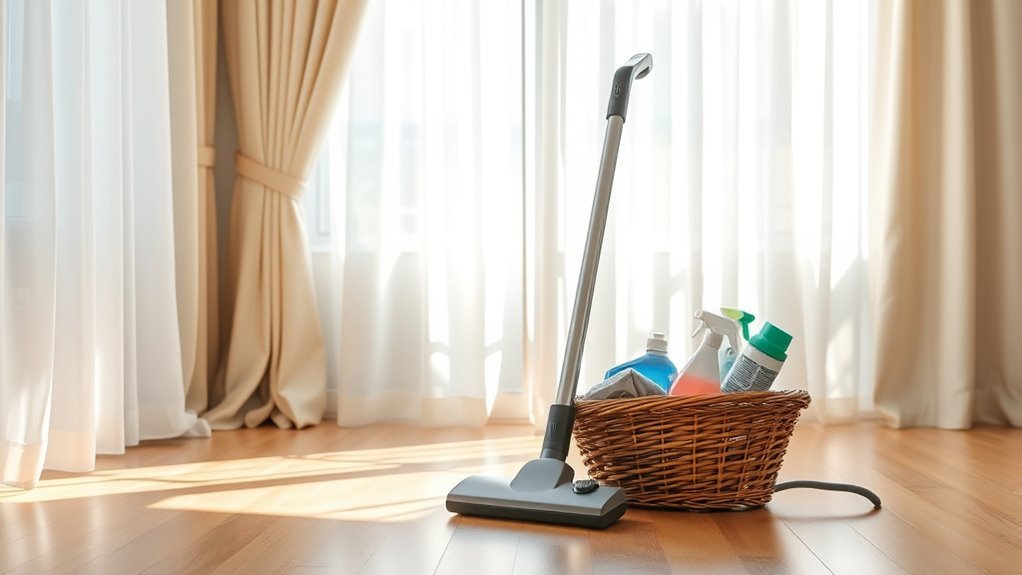
Before you plunge into deep cleaning your curtains and flooring, it’s important to prep the area properly to guarantee the best results. Start by identifying your curtain types—whether they’re sheer, velvet, or cotton—since each demands a unique approach. Next, consider the flooring materials underfoot; hardwood, tile, or carpet all react differently to cleaning agents and moisture. Clear the space by removing furniture and any fragile items to avoid damage. Vacuum your curtains gently to loosen dust, and sweep or vacuum your floors thoroughly. This preparation frees you to clean deeply without worrying about worsening stains or damaging delicate fabrics and surfaces. Taking these steps lets you embrace a fresh, revitalized space with confidence and ease.
Effective Methods for Cleaning Curtains
When cleaning your curtains, it’s important to use techniques that match their fabric type to avoid damage. You’ll also want to tackle stains quickly with the right removal methods to keep them looking fresh. Let’s explore some effective ways to clean different materials and handle common stains.
Fabric-Specific Cleaning Techniques
Since different curtain fabrics react uniquely to cleaning methods, you’ll need to tailor your approach to avoid damage and guarantee thorough cleaning. For silk curtains, gentle care is key—use a mild detergent with cold water, and avoid wringing to preserve their delicate texture. Let them air dry naturally to prevent shrinking or distortion. When dealing with upholstery fabrics, vacuum regularly to remove dust and consider steam cleaning for a deeper refresh without harsh chemicals. Test any cleaner on a hidden area first to verify it won’t cause fading or damage. By respecting each fabric’s needs, you maintain their beauty and extend their life, freeing you from constant worry about ruining your curtains while keeping your home fresh and inviting.
Stain Removal Tips
Dealing with stains on your curtains can feel overwhelming, but tackling them quickly and correctly makes all the difference. Start by blotting the stain gently—never rub—to avoid pushing it deeper into the fabric. Use a mild detergent mixed with water, testing on a small hidden area first to respect the fabric care instructions. For stubborn stains, a mixture of vinegar and water can work wonders without harsh chemicals. Remember, stain prevention is key: consider applying a fabric protector spray to repel dirt and spills. Regularly vacuum your curtains to keep dust and grime at bay, which also helps prevent stains. By acting fast and following these simple steps, you’ll maintain your curtains’ freedom from stains and keep them looking fresh and vibrant longer.
Techniques for Deep Cleaning Carpeted Flooring
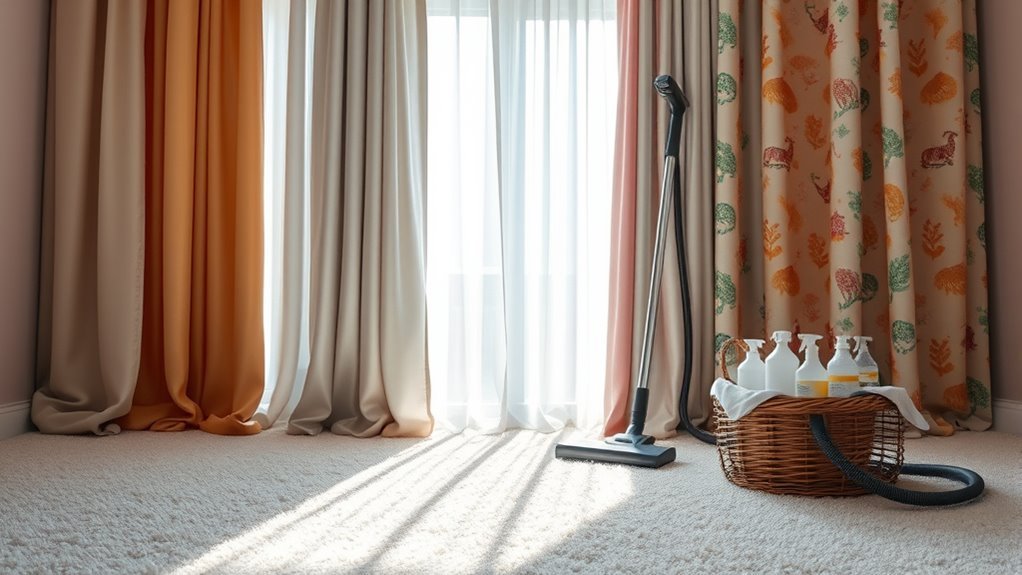
To keep your carpeted floors looking fresh, you’ll want to focus on effective stain removal methods alongside regular vacuuming and shampooing. Removing stains promptly prevents them from setting, while thorough vacuuming lifts dirt and debris. Shampooing then deep cleans, restoring your carpet’s appearance and extending its life.
Stain Removal Methods
Although carpet stains can feel stubborn, knowing the right removal methods makes deep cleaning much easier. Understanding different stain types and practicing stain prevention sets you free from constant worry. Here’s how you can tackle stains effectively:
- Blot immediately: For liquid stains, gently blot with a clean cloth to absorb without rubbing, avoiding deeper fiber damage.
- Use targeted solutions: Apply a mix of vinegar and water for organic stains or a gentle detergent for greasy marks, matching the solution to the stain type.
- Rinse and dry: After treatment, rinse with water and blot dry to prevent residue buildup and mold growth.
Vacuuming and Shampooing
Vacuuming and shampooing are two essential steps for keeping carpeted flooring fresh and spotless. You’ll want to vacuum regularly to remove dust, dirt, and allergens that settle deep in fibers, which also supports curtain maintenance by preventing dust circulation. When shampooing, use a gentle carpet cleaner and follow instructions carefully to avoid damaging the pile. This deep cleaning not only revitalizes your flooring’s appearance but also enhances flooring protection by eliminating embedded grime and bacteria. Remember to test any cleaning product on a small area first to guarantee it won’t cause discoloration. By combining vacuuming and shampooing, you take control of your space, maintaining a clean, healthy environment that complements your curtains and extends the life of your flooring.
Best Practices for Cleaning Hardwood and Tile Floors
When caring for hardwood and tile floors, you’ll want to use methods that protect their unique surfaces while effectively removing dirt and grime. Proper hardwood maintenance and tile care keep your floors looking fresh without limiting your lifestyle.
- Sweep or dust daily to prevent scratches on hardwood and avoid dirt buildup on tile.
- Use a damp mop with a mild cleaner designed for each floor type; avoid excess water on hardwood to prevent warping.
- Quickly wipe up spills to protect hardwood finishes and grout lines on tiles, preserving their natural beauty.
Recommended Cleaning Products and Tools
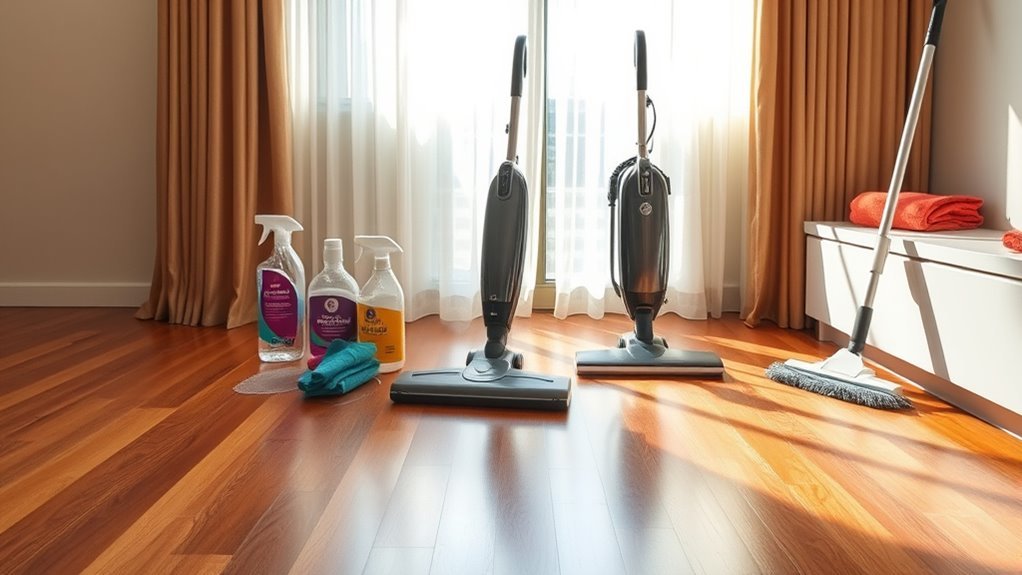
Choosing the right cleaning products and tools can make all the difference in maintaining your curtains and flooring. To keep things fresh while respecting your space and the planet, opt for eco friendly products. These are gentle yet effective, helping you avoid harsh chemicals that restrict your freedom to enjoy a healthy home. Essential tools like a microfiber cloth, a soft-bristle brush, and a handheld vacuum with attachments will help you reach every nook without damaging surfaces. For curtains, a fabric-safe spray or mild detergent works best. For floors, pH-neutral cleaners protect hardwood and tile finishes. By selecting these eco friendly products and essential tools, you empower yourself to deep clean confidently and sustainably, keeping your home vibrant and your routine simple.
Tips for Maintaining Clean Curtains and Flooring Longer
Using eco-friendly products and the right tools sets a solid foundation, but maintaining clean curtains and flooring over time takes consistent care. To enjoy lasting freshness and protect your freedom from constant chores, focus on these key strategies:
- Regular Dusting and Vacuuming – Gently remove dust from curtains and floors weekly to prevent buildup and keep fibers fresh.
- Spot Clean Immediately – Tackle spills and stains on curtains and flooring right away to avoid permanent damage and costly deep cleans.
- Rotate and Air Out – Shift rugs and open curtains daily to reduce wear and let fabrics breathe, enhancing curtain maintenance and flooring longevity.
Frequently Asked Questions
How Often Should I Schedule Professional Deep Cleaning for Curtains and Floors?
You should schedule professional deep cleaning for your curtains and floors about once or twice a year to keep things fresh and in great shape. For curtain maintenance, this helps remove dust and allergens that regular vacuuming can miss. Flooring care depends on your traffic level, but deep cleaning every 6 to 12 months prevents buildup and damage. Staying on top of these services gives you the freedom to enjoy a clean, healthy home without hassle.
Can Deep Cleaning Improve Indoor Air Quality?
Just like a fresh breeze sweeps through open windows, deep cleaning can refresh your space. When you keep up with curtain maintenance, dust and allergens don’t stand a chance, helping air quality rise like a morning sun. You’ll breathe easier and feel freer in your own home, unburdened by hidden grime. So, embracing regular deep cleaning isn’t just chore—it’s a step toward reclaiming your sanctuary’s pure, vibrant air.
Are There Eco-Friendly Alternatives to Chemical Cleaning Products?
Absolutely, you can choose natural cleaning options that align with sustainable practices, freeing you from harsh chemicals. Ingredients like vinegar, baking soda, and lemon juice work wonders and are gentle on both your home and the planet. By embracing these eco-friendly alternatives, you’re not only improving indoor air quality but also taking control of your environment in a way that’s healthier and more liberating. You’ve got the power to make greener choices every day.
How Do I Handle Mold or Mildew on Curtains and Floors?
If you spot mold or mildew, start mold removal by taking your curtains outside and brushing off loose spores. Wash them with a mixture of white vinegar and water to kill mold. For floors, scrub affected areas with a vinegar solution and let them dry completely to prevent mold’s return. To maintain mildew prevention, keep rooms well-ventilated and control humidity. This way, you’re free from harmful buildup without harsh chemicals.
What Are the Signs That Curtains or Floors Need Deep Cleaning?
Think of your home as a canvas—when curtain discoloration or floor stains start to show, it’s like paint fading or smudging, signaling it’s time for deep cleaning. If your curtains look dingy or floors have stubborn marks that won’t budge with regular tidying, you’re ready to reclaim that fresh, free vibe. Don’t wait for odors or dust build-up; those signs mean your space’s true colors are hidden beneath dirt.
